
Kara Chin in her studio
New Contemporaries artists Richard Ayodeji Ikhide, Kara Chin, Jack Fawdry Tatham, Carrie Grainger and Yuko Obe discuss mythology and alternative knowledges with the SLG’s Programme Coordinator Lily Tonge.
Lily Tonge: Could you describe your practice and any reoccurring themes or ideas you focus on?
Kara Chin: I make multimedia sculptures and installations, I use a range of mediums within this – animation, sound, woodwork, painting etc. I often have mechanical elements (desperately cobbled together) and my recent work has involved growing basil plants, and building hydroponic water systems for them. I would say the recurrent themes in my work are ideas around reality and simulation, human perceptions, transhumanism and a jumble of other futurist theories.
Yuko Obe: The personal search for mythological symbolism invariably finds a place in my work; sometimes quite direct but often abstractly. Many of the contemporary issues that I feel compelled to address have been answered in that way in the past.
Richard Ayodeji Ikhide: My practice looks at our relationship to Myth, how we can use Myth as a way to find commonality between ourselves and others, every culture on this Planet has one form of Myth or another. Carl Jung describes Myth as the Unconscious communicating to the Ego. My practice has a focus on Drawing as I feel the immediacy of Drawing allows me to communicate my ideas effectively, Also I see Drawing as an aspect of Artistic Practice almost everyone can relate to, As humans have been making marks on various surfaces for millenia.
Jack Fawdry Tatham: I love what Richard has just said and have lots of similarities within my work… I have been exploring imagery that reflects the changing balance of power between human and beast. I love and deeply enjoy drawing animals. Since the first cave drawings of animals to the present day our relationship with nature has changed exponentially. We have moved from feelings of fear and respect to exploitation and extinction. I choose to explore this imagery as it helps me to feel connected to nature and I hope it helps others to as well.
Carrie Grainger: I’ve really enjoyed reading all of your responses – so cool to see all the similarities in interests and concepts. My practice explores cultural superstitions, symbolism and ritual practice through mask making, performance and film. I draw on concepts from different belief systems surrounding spirituality, with a primary focus on shamanic belief and practice.
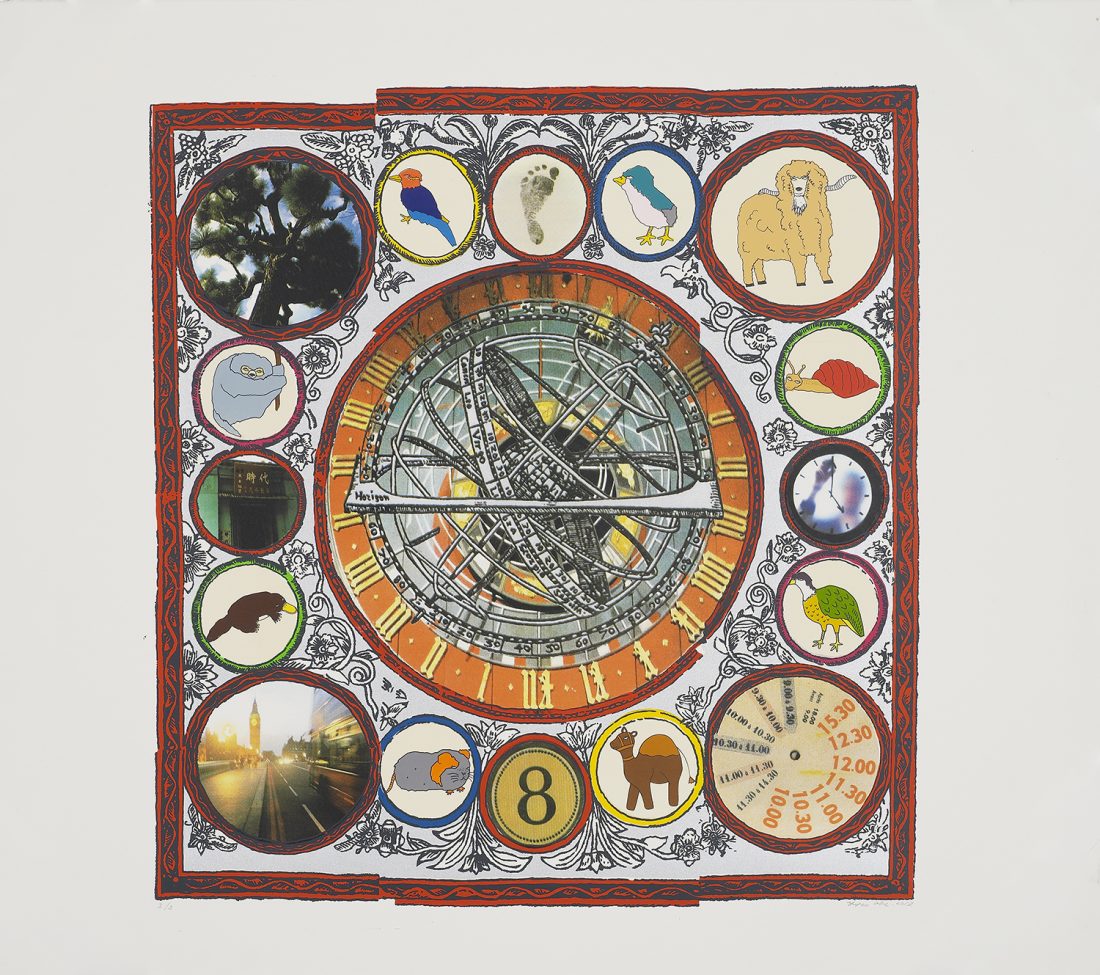
Yuko Obe, Interconnectivity of Life – Time, 2017, Screen print on paper, 85.2 x 89.7 cm
LT: Why did you choose to explore these themes within your work?
KC: These are really just the subjects I’m interested in, I never really have a specific agenda when starting to research something. I tend to just aggregate lots of things and eventually (hopefully) figure out how they fit together.
JFT: I want my work to be approachable and to tell stories about the human condition. This is what mythology, legends and folklore are very good at doing, they exist in the collective minds of humans of different ages and backgrounds. These myths exist in my work as a mix of my own imagined imagery with ideas or characters I have pinched from existing mythology, like the queen losing control of her coat of arms.
RAI: My choice to explore these themes is a way of trying to gain some sort of understanding about Myth, these symbols and images found within humanity’s past and to reconcile them with our current society, to form new understandings and relationships to our past.
I personally feel that humanity is in a state of Amnesia and we have lost contact with certain aspects of ourselves we were in tune with before. Graham Hancock (writer of Fingerprint of The Gods) talks about the Earth going through a state of mass Amnesia, because the further we look back into human history and the more archaeological finds are discovered, the more questions we have about these past civilizations. A lot of the meaning behind these images has been lost to us or taken on new meaning.
CG: I have always been interested in spirituality and how different cultures engage with and explore it. I believe that there is a re-emergence of spirituality in the UK and many other European countries such as neo-shaman and Wicca groups. I relate to what Richard said about humanity being in a state of amnesia, having lost touch with ourselves and our roots, which I think a lot of people perhaps want to engage with again through spirituality and a sense of community.
YO: I grew up in an area of Kyoto where Buddhist and Shinto mythology formed an integral part of my life. When I moved to the West for study I felt drawn to its own mythology perhaps to find familiarity. The symbolism behind the myths resonated deeply with me and I focus on the natural fusion and fellowship of the two very different cultures.
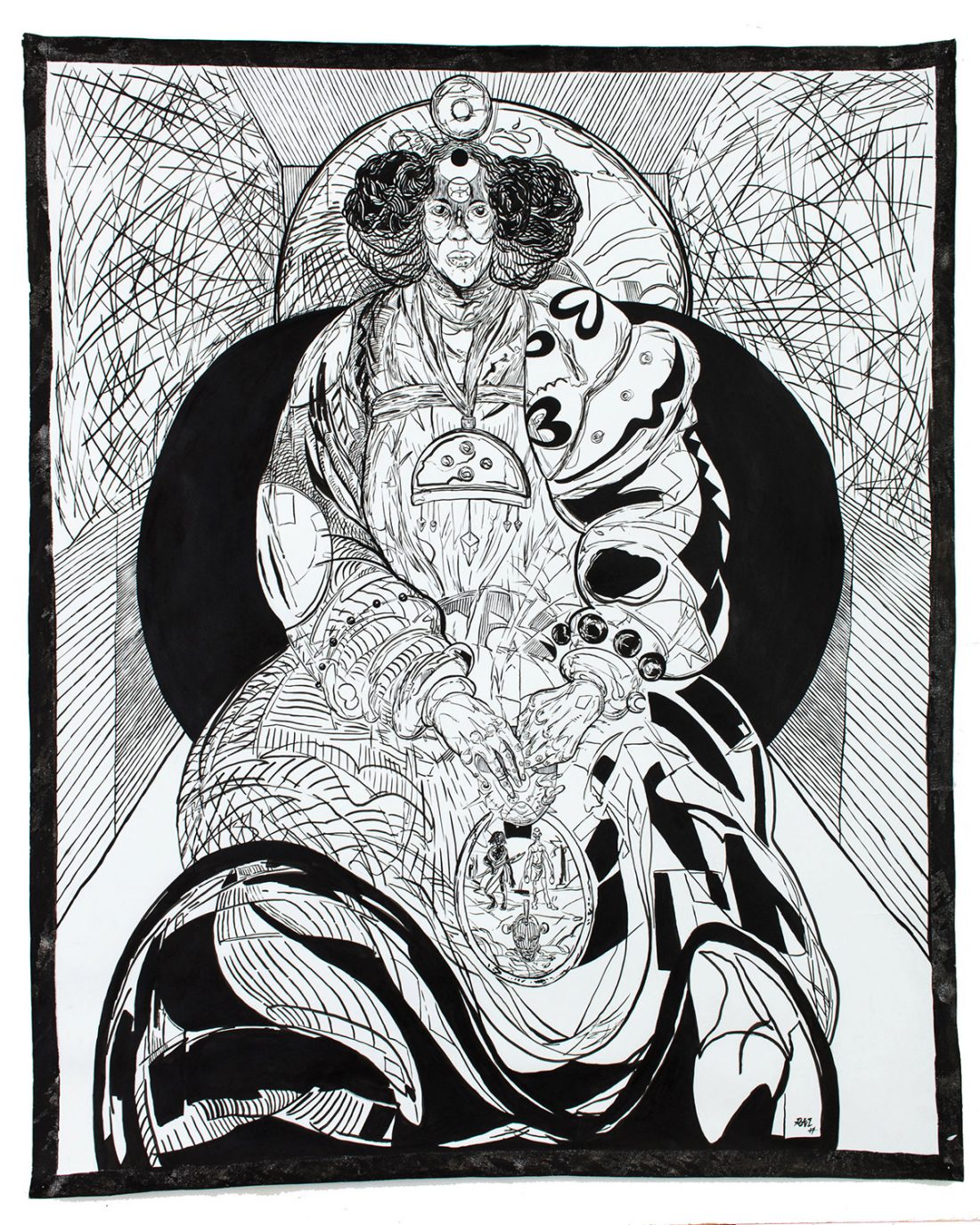
Richard Ayodeji Ikhide, IYA, 2017, Acrylic ink on paper, 103 x 90 cm
LT: Do you think mythology or alternate systems of knowledge are a part of your practice?
YO: Mythology, wherever it is generated, is really no more than an attempt by earlier generations to make sense of their world and its problems. A lot of effort went into solving issues that often still exist and I try to connect with the efforts of past generations in my work.
RAI: I feel Myth serves the purpose of personifying certain psychological states within humans. Before the day of the modern psychoanalyst, Ancient Man must have had no other way to define these psychological states but to create images as most Ancient societies did not have very developed language systems. Symbol making or creating Myths speak directly to the individual.
Jung talks about humanity being connected to these primordial images via the collective unconscious which we all share as a species. Artists, I feel, are in a great position to translate some of these intangible abstract things in the psyche into images and stories in the form of Myth. In creating images, a lot of my pieces arise from an amalgamation of Myths I might have looked into, certain Ancient sculptures or art works, or personal experiences which I translate into Mythological ideas.
CG: I think that mythology and folklore are roots of belief systems and spirituality and that they are important in keeping us connected to our own roots. I draw inspiration from ancient mythology, folklore and also the urban legends of today. In my practice I like to form links and combine different cultural elements to create my own characters and hoaxed narratives.
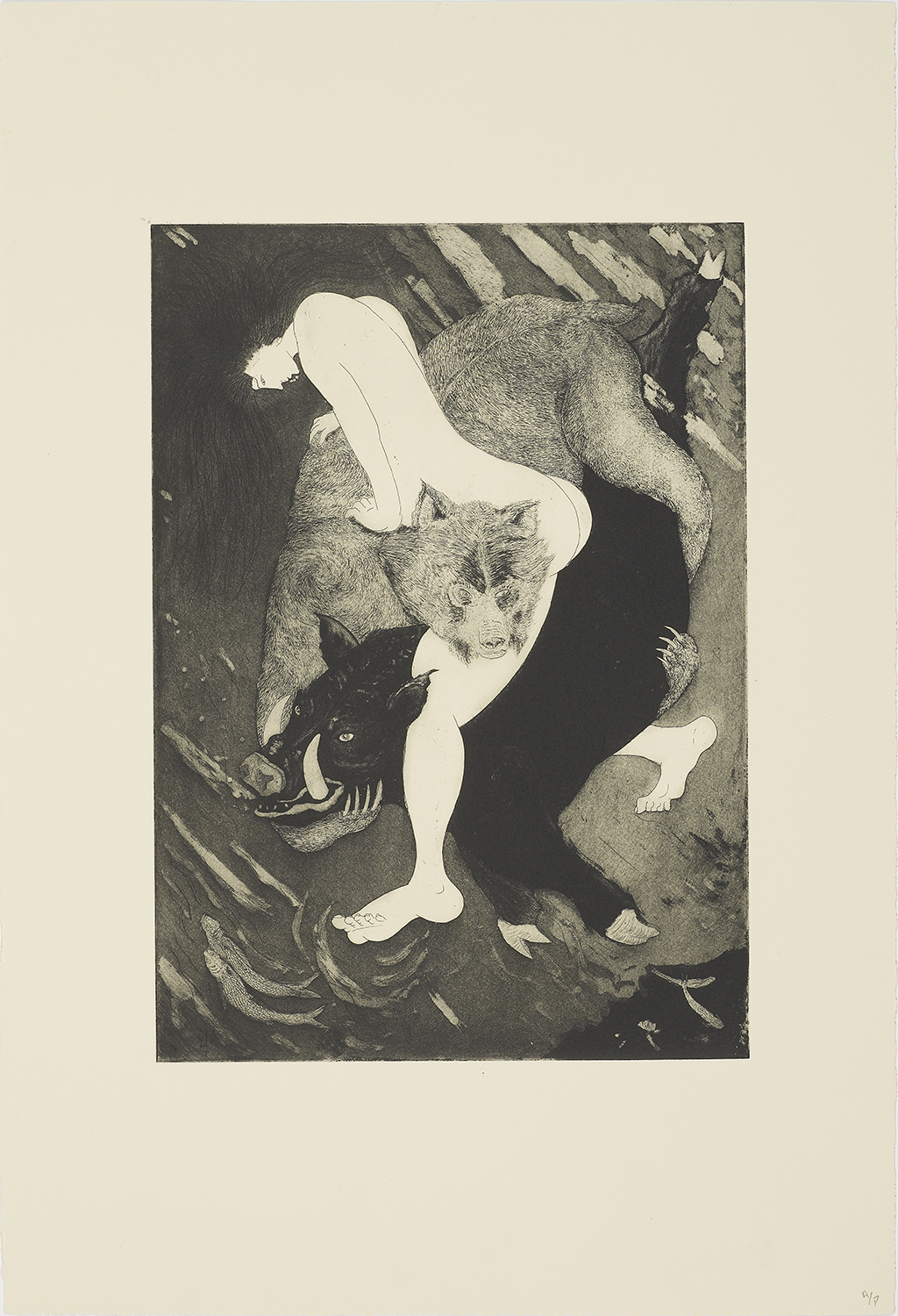
Jack Fawdry Tatham, Among the bearded bear, 2017, Etching with aquatint and dry point, 35 x 25 cm
KC: I use the word fiction at this point as in my mind myth has a time dynamic attached to it – it’s something seated in the past and the ideas I’m looking at are usually set somewhere in the future. My work often combines mechanical devices and digital media, with more traditional forms of craft (ceramics, woodwork etc) and the clash of these creates a sort of temporal limbo. There’s a juxtaposition of implied future technologies and more natural materials that tether something organic and ancient, and I think the fusion of these causes the installations to take on a sense of being from both past and future civilisations. Hence the narratives floating about them become mythic
When I make a sculpture the questions I tend to ask aim to personify the being I have created. How does that chair feel about people sitting on it? If I’m trying to explore a concept that’s too big for me, I’ve found it really useful to try and come up with some kind of fiction around it, and use this to dictate the work.
So as an example, a previous project of mine stemmed from Nick Bostrum’s theory that if technologically-mature future civilisations run simulations of past civilisations that are indistinguishable from reality, then we are most likely in one of those simulations now. I’ve made a succession of works about a civilisation of blobby fish characters (often appearing in ceramic form) who come to realise that their reality is actually a simulation, and so the work has sort of grown around how they would react to that information.
Continuing this narrative spawned a whole load of new ideas and research on my part. I figured that once the blobby fishes had come to terms with the fact that their reality is simulated, they’d probably all be harking back to the good old days when they still felt real. So that took me into exploring ideas of sensory immersion and theories of the phenomenal self, using sensory stimuli to trigger awareness of one’s body and existence. I made a series of fictional future robotic creatures that grew basil plants and plodded around wafting the scent everywhere.
Basically I think incorporating fictional plots into my work has enabled me to explore multiple theories, in many different directions, and assemble them into something palatable.
JFT: I am really keen on this idea that art can destabilise reality. I personally use art as a way to regain some control of life. Destabilise reality and then rebuild it with my own ideas and hopes for the future. For a lot of my work this manifests itself with humans and animals interacting with each other. I often look to the past for inspiration, knowing that humanity has often been much closer to nature and has entwined its mythology with animals. Making work about this helps to reconnect to this feeling. I find myself nostalgic for a time I can’t remember and my pictures help me to feel more at ease. I am very similar to the “blobby fishes that have come to terms with the fact that their reality is simulated”.
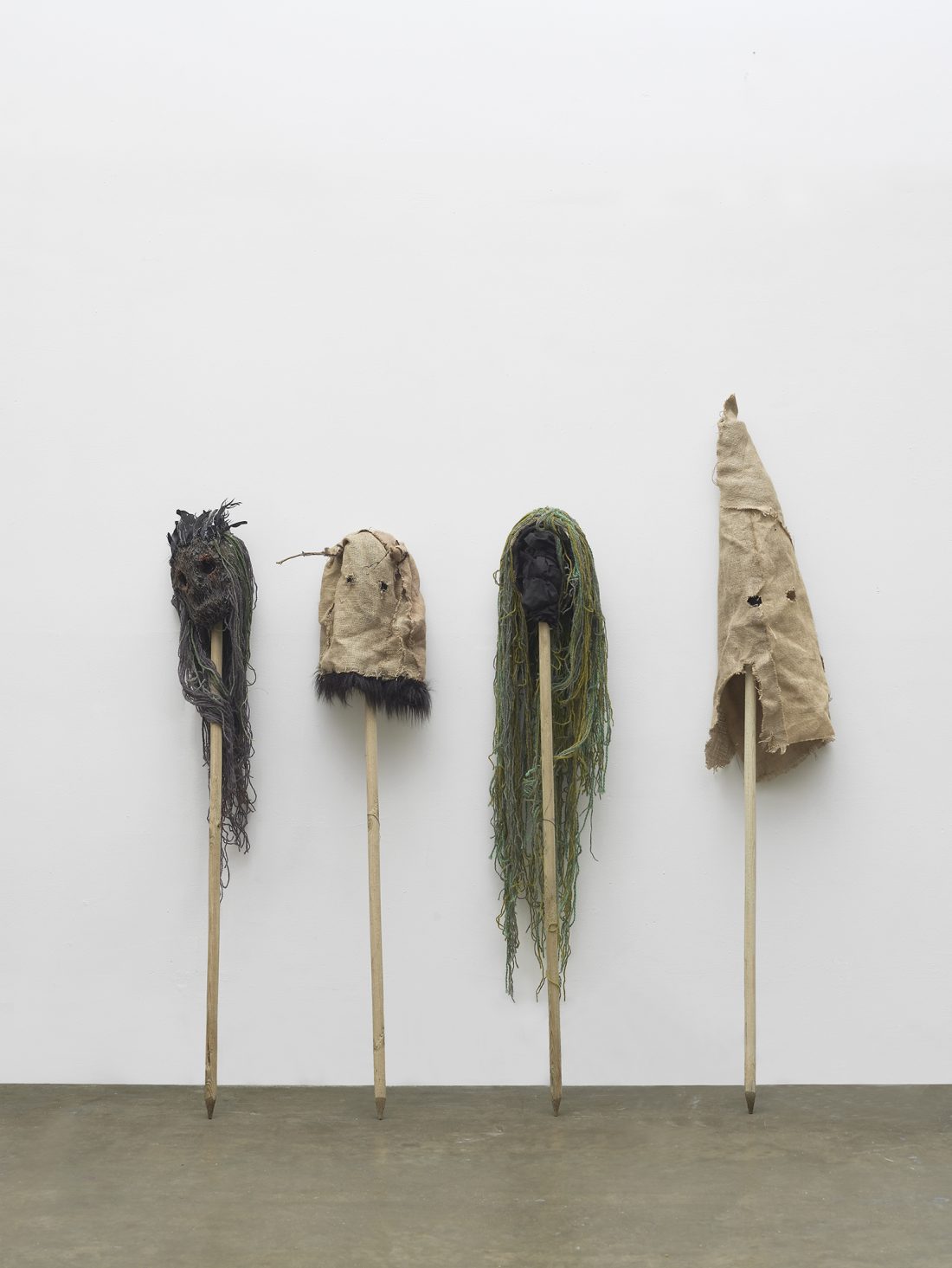
Carrie Grainger, The forest has eyes, 2017, Hessian, wood, yarn, plaster, hot melt, horse hair, feathers, twigs and soil, 200 x 180cm x 30 cm (each)
LT: I see that these speculative ways of approaching the present can really help to destabilise the present, and also question a sort of linear narrative whereby we all desire the same singular end goal. I am interested in how destabilising this through myth or fictions can be a way to imagine ‘possible progressive future societies’ as Kara said. I wonder what you all think?
JFT: Looking back at old stories can help us reflect and make new stories for the present. Mythology can constantly change and evolve with us. In the past oral tradition played a key role in keeping myth alive, as we move away from an oral history, it is the important job of the arts to gather people together and keep mythology alive…
RAI: We shouldn’t do away with Myths and see ourselves as totally divorced from the past but look to the past as a way to understand where we are going as a species. Finding parallels between different Mythologies shows we aren’t so different, yes outwardly we might look different, but I feel the inner essence of humanity which a lot of Myths speak to is essentially the same thing just expressed differently. I think this can help us find commonalities with each other in today’s society.
CG: Many have lost touch with their roots and have also lost touch with nature. I think that humans are tribal by nature and desire a sense of belonging, to be a part of a community. That being said, there are still ancient traditions and a sense of community that are going strong even after thousands of years. I think this is important to not only keeping community traditions going but also for bringing people from all different walks of life together and forming those conversations and bonds.
KC: I like Donna Haraway’s ideas around using science fiction as a way to imagine possible progressive future societies, so maybe exploring fictional future civilisations and technology in artworks similarly could be a way to consider potential futures and from these reflect on our own beliefs and behaviours in the present.
YO: The search for answers requires both forward and reverse thinking. I feel that our present society often forgets lessons and knowledge from the past in our rush toward solutions.
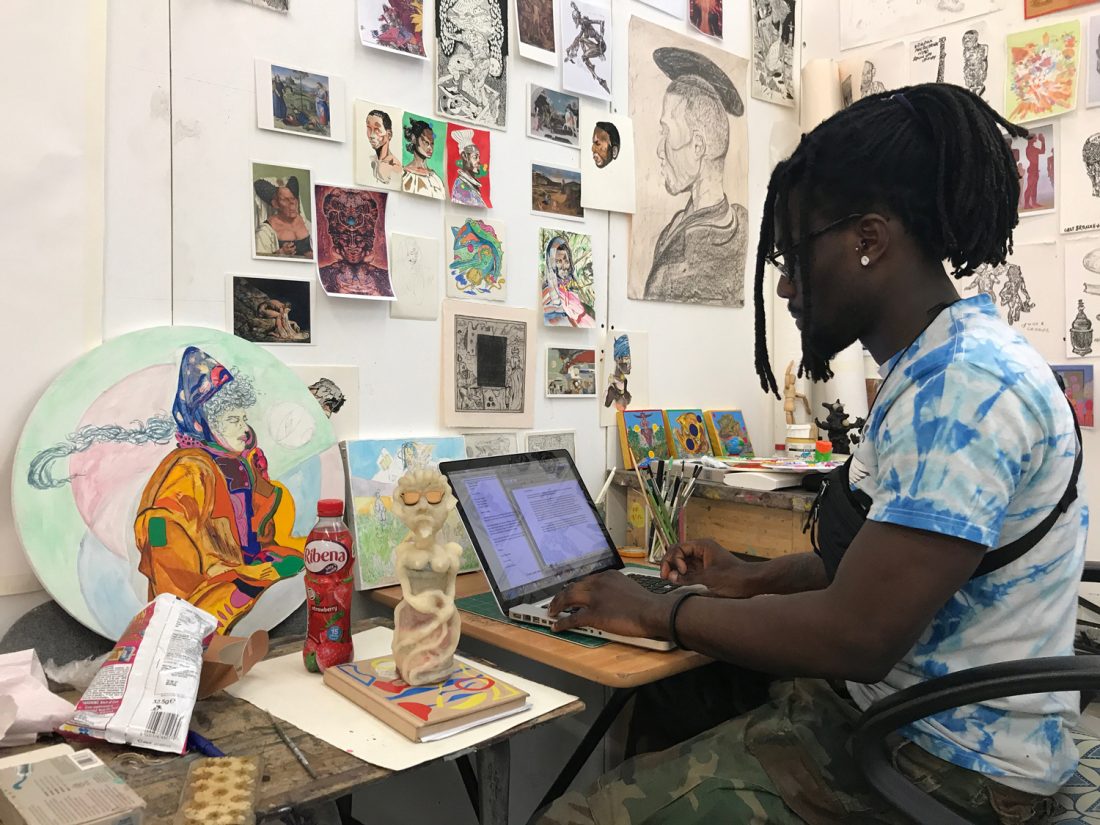
Richard Ayodeji Ikhide in his studio